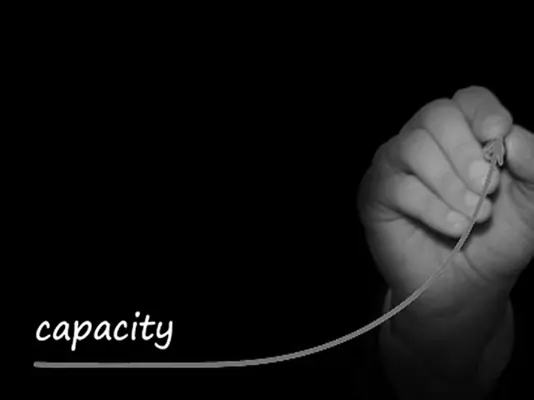Exploiting sales capacity
Satyashri Mohanty & Dr. Shelja Jose Kuruvilla

When the winds of change blow, some people build walls, and others build windmills. – Chinese Proverb
Market demand in B2B markets is stagnating. The number of new orders bagged by Indian companies fell by 30 percent in 2015 compared to the previous year.1 This is attributed to the fact that the Indian manufacturing and infrastructure sector has been stagnant in the recent past. India’s core sectors (coal, crude oil, natural gas, refinery products, fertilizers, steel, cement, and electricity) recorded a growth rate as low as 1.4% in 20152. This has left many Companies watching helplessly at escalating costs while sales are flat or falling. They are aware that the way to harness sales volumes in a stagnating market is to expand their customer base aggressively. However, in the B2B space, customer acquisition is not an easy job. Numerous meetings with different managers in client organizations, followed by technical approvals and demos, may be required to land the first order.
The effort and time taken to get an order from a new customer is usually much higher than that required for getting reorders from the existing customer base. So, more the number of customer interactions more would be the sales. Consequently, the current narrative of the top management in almost every B2B organization is “go out in the market… spend less time in office”. On the face of it, this instruction sounds odd – aren’t the sales people already expected to spend most of their time in the field?
Analysis of how sales teams use time
Vector Consulting Group analyzed how sales managers in equipment manufacturing companies spend their time. The results provide an interesting insight.
- Salesmen put in long hours at work. Many of them (33-43%) work overtime
- Salesmen spend as much as 65-80% of their time doing sales support activities!
- 80-85% of field visits of salesmen are limited to existing customers
- Only 15-20% of these visits are to potential customers

If we define the core competency of a salesman as the ability to bring about buy-in for company products through customer interactions, then all other tasks can be described as sales support activities. The top capacity guzzlers of a salesman are these sales support tasks related to pre-order and post-order - right from ensuring clean order entry in the system to all customer follow-up tasks during order execution. Most of these support tasks require easy access to IT systems, rigorous documentation, and strong coordination with customers and other internal departments making it necessary for sales managers to spend most of their time in local branch offices rather than on field visits. Moreover, even though each of these support tasks (as shown in table 1) done by a salesman looks small, they cumulatively not only use up their capacity but also waste it. Every enquiry to order cycle or an order to collection cycle is interspersed with numerous small tasks. Each of them is typically iterative in nature and has to be done in small periods of time; else they are likely to become urgent. For example, if an enquiry comes in and the proposal has to be sent in in the next five days, the salesman is forced to drop everything and process the enquiry. Alternatively, if a dispatch is held up for want of inspection during the month end, most often, the salesperson is asked to step in to sort it out. Then, the salesperson will most likely drop everything else to facilitate the dispatch. (In many organizations, the sales team spends the last week of the month just trying to ensure dispatches and invoicing, wasting a clear 1/3rd of their capacity). When each salesperson handles about 10 to 15 open sales orders and 10 to 15 open enquiries, the number of open support tasks can be as high as 50 to 100. All these 50 to 100 tasks, with low lead-time service requirements, create a cycle of perennial urgency and bad multi-tasking for the salesperson. Moreover, all these tasks affect the rate of order intake as well as the rate of final billing to the customers. So, to use time better and avoid perennial switching between different types of tasks, sales teams try to batch various types of tasks across different sales orders into time buckets. (Such batching is one of the reasons for spikes in order booking and dispatches in many organizations). But, despite this, the capacity available for actual sales work (acquiring new customers or selling new products to existing customers) is little, and very often, the efforts required to acquire a new customer look disproportionately high with respect to immediate results. Consequently, salespeople are in a perpetual conflict.
On the one hand they have to meet new customers to establish a new business, and on the other, they have to focus on support activities to ensure that they meet their monthly order booking and sales targets. Their capacity is currently completely taken up by the second. So, even if the board rooms resonate loudly with the demand for expansion of customer base to increase market share, as long as this conflict is not resolved, nothing is likely to change.
A solution that does not work
To release the salespeople capacity, they have to be released from having to chase sales support tasks. But building a backend support team that truly serves its purpose is not simple. Many companies have tried this and burnt their fingers. To free up some of their salespeople’s time, some companies, particularly the ones with multiple business units and geographically spread out branch locations, have tried to create a commercial function at branches to support the backend work like order entry, material follow up, and dispatches. But this did not work as expected for two reasons. For one, the support team did not have the authority to interact with customers directly. They could complete their tasks only with information and help from the sales team. The prime responsibility and accountability of support tasks resided with the sales force. Secondly, the support team also had other unrelated responsibilities limiting their availability to undertake support tasks in a timely manner. When tasks were missed or were incomplete, the salespeople had to follow up with them. So, the support team was not perceived as adding any value. On the contrary, it was seen as just adding another layer to the bureaucracy the sales team had to wade through.
The core problem
The only way out of this conflict is to question the fundamental assumptions of how sales as a function is structured. The two critical assumptions under the current organization of sales are as below:
- All customers want a single window of communication for all matters regards to sales and sales support activities
- Accountability, and hence, the responsibility of all activities related to order intake and final billing should reside with the individual sales team.
The first assumption is flawed, and the second one is costly. Customers need to be able to reach out to the company and have access to the relevant information without having to repeat themselves continuously. But it is irrelevant whether this is to the same person who sold their product to them. In fact, in many situations, they prefer to talk to an expert rather than a person who just acts as a contact point without having the necessary competency to deal with the queries. The banking sector works very effectively with multiple windows – customers interact with the call center, website, and branch offices without feeling the need to talk to just one person.
The price organizations pay for the second assumption is the tremendous loss of sales capacity.
Releasing sales capacity
What is needed to resolve this dilemma is a method by which the non-sales or support activities are taken up in a manner that ensures clockwork efficiency and reliability without using the sales capacity for any kind of coordination. For this, a streamlined backend has to work directly with customers with machine-like efficiency! Only then will the sales team have the confidence to let go of the support activities.
In order to ensure that the backend is streamlined,
- The support team has to be centralized so that there is an aggregation of work across branches, making a dedicated team for support tasks viable.
- The team should have direct access to customers.
The universe of tasks have to be standardized with clear handover criteria and then divided between different teams based on time and skill requirements (e.g., payment follow-up, design follow-up, etc.). This reduces the need for multi-tasking of the support team and improves their ability to get back to a task after natural interruptions. (The need to distribute support tasks across different resource types is another reason why the support activities need to be centralized for maximum aggregation benefits).
Service Level Agreements have to be in place which clearly defines scope and responsibilities. The entire back-end has to be managed like a shop floor with real-time evaluation of tardiness and right-time expediting.
The process has to be automated wherever possible, especially the big volume, repetitive tasks.
When all work together seamlessly, much like various stages of a production process, expediting customer calls to the field sales team will quickly reduce to zero. This will build confidence in them to concentrate on ‘real sales’.
Improving sales team productivity
An effective backend may release approximately 70% capacity of the salespeople, but this still does not prevent further wastage. Research indicates that half of the time an average salesperson spends on customer calls gets used for traveling and another two-thirds are spent waiting to meet customers. Since customers tend to be geographically spread, this limitation makes salesmen pick and choose whom to visit. They generally meet only those whom they believe are most likely to give them an order. Many opportunities for building relationships and influencing orders in the company’s favor at pre-bid stages are thus missed in this bargain.
So in order to use the salesperson’s time better, it may be useful to analyze the customers a company serves and see if they can be serviced effectively without any wasteful travel. There are essentially two kinds of customers – repeat customers or existing customers - who have given at least one order, and new customers who have to be targeted for business development (for acquiring the customer or increasing share of business).
Repeat customers:
Repeat customers or existing customers have already demonstrated their conviction in the company’s brand by purchasing from the company. Still, maintaining the relationship through continuous contact is important. With a paucity of time, most sales peoples leave out a large dormant customer base from their regular contact schedule. But the good news is that since product demos and expert selling skills are not required, a good portion of these interactions can be conducted through a phone beat that can reach a much larger base than what travel can accomplish! These phone beats can be done by a separate team that focuses on reaching out to the entire customer base in a pre-defined rhythm. Travel for physical meetings, then, needs to be done by the field sales only when the customer specifically requests for one.
This approach requires sales with an existing customer base to be handled by teams of two groups of resources working in tandem – internal sales and field sales. But the advantage of this is that most of the transactions (including the closing of sales) are taken care of by the internal sales partner by directly interacting with the customers. And since the field salesman makes only scheduled meetings, set up by the internal sales partner, with a definite agenda, his travel is focused and more rewarding.
-New customers/new products to existing customers (business development)
Selling to new customers or a new business development requires a much longer time and involves a series of physical meeting/s with the customer. This also requires a higher degree of expertise to understand the customer’s requirements, knowledge of the company’s products, and selling skills. At the same time, approaching every new customer requires a cold call. The expert salesperson, however, finds cold calls very unpleasant.
Here again, tasks related to the ‘cold call’ phase – setting up the meetings and making the sales call can be divided. Centrally located campaign coordinator/s can develop the database, filter potential opportunities through e-mail or phone interactions, and schedule visits for the expert salesperson to woo the customer. This team can also take care of all the non-sales activities needed to support business development. Once a new sale is finalized, the customer can be handed over to the team servicing repeat customers.
When internal sales activities are as per process, and sales visits are pre-scheduled, the sales funnel will be a lot more transparent than what it currently is. Monitoring of the sales tasks can be done by checking the progress of orders in the funnel. Each order can be mapped to be in various stages of the sales funnel with the help of any standard CRM package, and if a task is indicated as stuck, help can be provided proactively for speedy issue resolution. Efforts should be made to improve the flow from lead generation to billing. Improved flow will, over time, reflect as an increase in sales.
Changing the paradigm
At the very core of this new paradigm is the Theory Of Constraints approach of taking all possible steps to subordinate to the identified constraint. This is the only way to ensure maximum usage of the capacity of the constraint. The subordination steps involve reorganizing the sales function and an even greater revolution in thought. But when multiple people (centralized back-end, internal sales teams, field salespeople, and business development managers) work together to make the sales happen, there will be a quantum jump in sales productivity while ensuring improved quality of service. Moreover, sales will cease to be a ‘black box’ as it is often considered now and become more transparent. Since this model is expected to free up a considerable amount of sales capacity, the company may also find itself with surplus salespeople. The approach also opens up new possibilities for re-defining and aggregating branch and geographical locations.
1http://www.business-standard.com/article/companies/new-orders-slow-down-for-india-inc-in-september-quarter-115100700386_1.html
2http://www.dnaindia.com/money/report-why-india-s-core-sectors-continue-to-slow-down-2073680
Featured Case

Transforming Sales and Business Development








